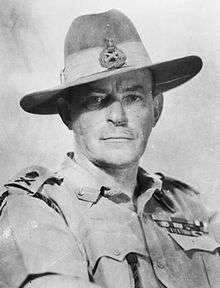Montagu Stopford
- Not to be confused with his grandfather, the 19th century admiral Montagu Stopford (admiral).
| Sir Montagu Stopford | |
|---|---|
 Sir Montagu Stopford c.1945 | |
| Born |
16 November 1892 Hanover Square, London |
| Died | 10 March 1971 (aged 78) |
| Allegiance |
|
| Service/branch |
|
| Years of service | 1911–1949 |
| Rank | General |
| Unit | Rifle Brigade (Prince Consort's Own) |
| Commands held |
17th Infantry Brigade 56th (London) Infantry Division Staff College, Camberley XII Corps XXXIII Indian Corps Twelfth Army South East Asia Command Northern Command |
| Battles/wars | |
| Awards |
Knight Grand Cross of the Order of the Bath Knight Commander of the Order of the British Empire Distinguished Service Order Military Cross Mentioned in dispatches |
General Sir Montagu George North Stopford GCB, KBE, DSO, MC (16 November 1892 – 10 March 1971) was a senior British Army officer who fought during both World War I and World War II, where he became Commander-in-Chief South East Asia Command from 1946 to 1947.
Early life
Stopford was the son of Colonel Sir Lionel Arthur Montagu Stopford, and the great-grandson of James Stopford, 3rd Earl of Courtown. His mother was Mabel Georgina Emily, daughter of George Alexander Mackenzie. He was educated at Wellington College and at the Royal Military College, Sandhurst. He was commissioned as 2nd lieutenant into the Rifle Brigade in 1911, serving with the 2nd Battalion of the regiment in India until 1914.[1]
First World War
He fought in the First World War,[1] where he was mentioned in despatches and awarded the Military Cross, having entered France as a lieutenant with the 2nd Battalion, Rifle Brigade (Prince Consort's Own) on 6 November 1914 (Medal Index Card, Kew, England), and become G.S.O.3 of the 56th (London) Division, Territorial Force, on 10 June 1916, as a captain. On 6 December 1916 he became the Brigade-Major of the 56th Division's 167th (1st London) Brigade, a post which he held thru to 25 March 1918 ('56th Division' by C. Dudley-Ward, Pub. 1921). He ended the war with the substantive rank of major.
Second World War
Immediately before the outbreak of World War II, Stopford was an instructor at the Staff College, Camberley. He commanded the 17th Infantry Brigade, part of the British Expeditionary Force (BEF), from 1939 to 1940, leading the brigade during the Battle of Arras.[1] He was General Officer Commanding 56th (London) Infantry Division from 1940 to 1941 and then became Commandant of the Staff College, Camberley in October 1941.[2] He commanded British XII Corps from 1942 to 1943[3] and XXXIII Indian Corps in Burma from 1943 to 1945.[1] He finally commanded the British Twelfth Army, formed in Burma in 1945, which defeated the Japanese breakout attempt in the Pegu Yomas in July and August of that year, the last action of the war.[1]
After the war Stopford served as commander of Burma Command (renamed from Twelfth Army) from 1945 to 1946, as Commander-in-Chief Allied Land Forces in the Dutch East Indies in 1946 and as Commander-in-Chief South East Asia Command from 1946 to 1947 before becoming General Officer Commanding-in-Chief Northern Command from 1947 to 1949.[1] He retired from the British Army in 1949,[1] with the rank of general. He was also appointed Colonel-in-Chief of the Rifle Brigade.
Stopford was awarded the Distinguished Service Order in 1940 and made a Companion of the Order of the Bath in 1942. In December 1944 he and his fellow corps commanders Philip Christison and Geoffrey Scoones were knighted and invested as Knights Commander of the Order of the British Empire by the viceroy Lord Wavell at a ceremony at Imphal in front of the Scottish, Gurkha and Punjab regiments. William Slim was knighted and invested as a Knight Commander of the Order of the Bath at the same occasion.
Later life
After the war Stopford was further made a Knight Commander of the Order of the Bath in 1947 and a Knight Grand Cross of the Order of the Bath in 1948. In 1962 he held the honorary post of Deputy Lieutenant of Oxfordshire. He lived at Rock Hill House in Chipping Norton.[4] He married Dorothy, daughter of Lieutenant Colonel Henry Foulkes Deare, in 1921.[5] They had no children. His wife died in 1982.
References
| Military offices | ||
|---|---|---|
| Preceded by Claude Liardet |
GOC 56th (London) Infantry Division January 1941– October 1941 |
Succeeded by Eric Miles |
| Preceded by Robert Collins |
Commandment of the Staff College, Camberley 1941–1942 |
Succeeded by Sir Alan Cunningham |
| Preceded by James Gammell |
GOC XII Corps 1942–1943 |
Succeeded by Neil Ritchie |
| Preceded by Philip Christison |
GOC XXXIII Indian Corps 1944–1945 |
Succeeded by Post redesignated Twelfth Army |
| Preceded by New post |
GOC Twelfth Army May 1945 – November 1945 |
Succeeded by Post redesignated Burma Command |
| Preceded by Earl Mountbatten |
GOC-in-C South East Asia Command April 1946 – September 1946 |
Succeeded by Post disbanded |
| Preceded by Sir Philip Christison |
GOC-in-C Northern Command 1947–1949 |
Succeeded by Sir Philip Balfour |
| Preceded by Sir Ralph Eastwood |
Colonel Commandment of the Rifle Brigade (Prince Consort's Own) 1951–1958 |
Succeeded by Sir Francis Festing |